
Phycology is the scientific study of algae. Also known as algology, phycology is a branch of life science.

The blackspot shark is a small species of requiem shark in the family Carcharhinidae found in the tropical Indo-West Pacific Ocean between latitudes 24°N and 30°S, from the surface to a depth around 40 m (130 ft). Its length is a little under one meter (yard) and it is not considered to be dangerous to humans. It feeds mainly on fish, crustaceans, and squid. This shark is also caught in small-scale fisheries for human consumption.
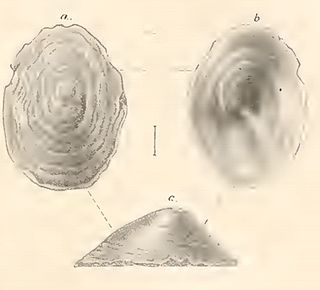
Pseudococculina is a genus of sea snails, marine gastropod mollusks in the family Pseudococculinidae.

Astralium provisorium is a species of sea snail, a marine gastropod mollusk in the family Turbinidae, the turban snails.
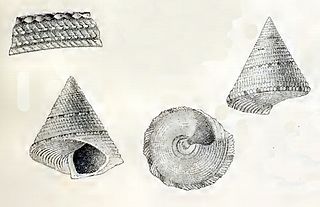
Calliostoma quadricolor is a species of sea snail, a marine gastropod mollusk in the family Calliostomatidae.
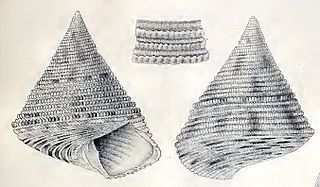
Calliostoma rufomaculatum is a species of sea snail, a marine gastropod mollusk in the family Calliostomatidae.

Marrus orthocanna is a species of pelagic siphonophore, a colonial animal composed of a complex arrangement of zooids, some of which are polyps and some medusae. Swimming independently in the mid-ocean, it lives in the Arctic and other cold, deep waters. It is a colonial creature that is born from a single egg which is fertilized. Later on, a protozoan form that eventually grows to form more duplicating members of the colony. It belongs to the order siphonophorae and the family Marrus. Other species in the family include the Marrus antarcticus, Marrus claudanielis, and Marrus orthocannoides.

Agalmatidae, or Agalmidae, is a family of siphonophores.

The Abylidae are a family of marine invertebrates in the order Siphonophorae. They are colonial, but the colonies can superficially resemble jellyfish; although they appear to be a single organism, each specimen is actually a colony of Siphonophora.

Mattheus Marinus Schepman was a Dutch malacologist. He was one of the foremost collectors of mollusc shells in the Netherlands, and was also high on the overall list of European collectors.
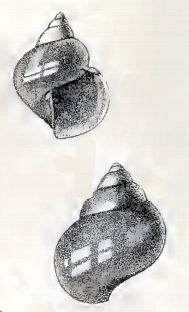
Guttula sibogae is a species of extremely small deep water sea snail, a marine gastropod mollusk in the family Seguenziidae.

Apolemia is a genus of siphonophores. It is the only genus in the monotypic family Apolemiidae.
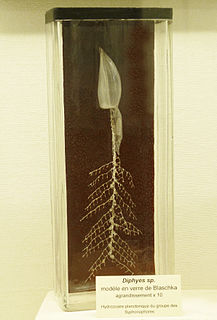
The Diphyidae are a family of siphonophores. These are colonial siphonophores with two nectophores arranged one behind the other. The front one includes a somatocyst, while the hind one does not. The somatocyst often contains an oil droplet for buoyancy control. A nectosac in each nectophore allows the organism to swim efficiently.

Muggiaea atlantica is a species of small hydrozoan, a siphonophore in the family Diphyidae. It is a cosmopolitan species occurring in inshore waters of many of the world's oceans, and it has colonised new areas such as the North Sea and the Adriatic Sea. It is subject to large population swings, and has been held responsible for the death of farmed salmon in Norway. The species was first described by J.T. Cunningham in 1892 from a specimen obtained at Plymouth, England.

Physonectae is a suborder of siphonophores. In Japanese it is called 胞泳.

Calycophorae is a suborder of Siphonophores alongside two other suborders Physonectae and Cystonectae. This suborder includes the giant siphonophore, ; one of the longest lengthwise extant creatures (40–50m). While the Physonectae have a pneumatophore, nectophore, and a siphosome, Cystonectae lack a nectophore, and Calycophorae lack a pneumatophore. From the bell-shaped nectophores, Physonectae and Calycophorae are called Codonophores or Greek for bell-bearers. The distribution, morphology, and behaviors of Calycophorae species are vast and greatly depend on the species. Calycophoraes typically consist of two nectophores with a siphosome that have many tentacles that grow out of the siphosome. The Calycophoraes move by propelling water out of the nectophore much like how jellyfishes move. The tentacles act as fishing nets where the nematocysts on the tentacles paralyze their prey which are then later fed on. Calycophorae have three life stages, which are the larval development stage, the polygastric stage, and the eudoxid maturation stage. Each Calycophorae colony forms from one fertilized egg.

Abyla is a genus of colonial siphonophore in the subfamily Abylidae and the suborder Calycophorae. The genus contains three species and was established by Quoy and Gaimard in 1827.
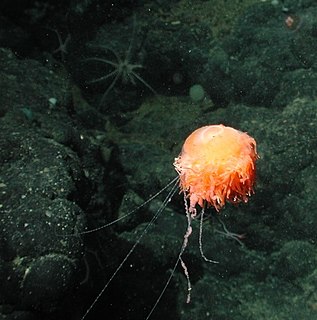
Rhodaliidae is a family of siphonophores. In Japanese they are called ヒノマルクラゲ.

Abyla bicarinata is a colonial siphonophore in the family Abylidae. It was described in 1925.

Abyla trigona is a colonial siphonophore in the family Abylidae. It was described in 1925.


















